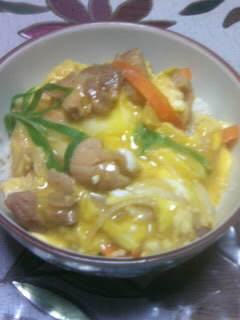
Kimchi-Kimchi (pronounced /ˈkɪmtʃi/, Korean pronunciation: [kimtɕʰi]), also spelled gimchi, kimchee, or kim chee, is any one of numerous traditional Korean pickled dishes made of vegetables with varied seasonings. A common manifestation is the spicy baechu (cabbage) variety. Kimchi is the most common banchan, or side dish, in South Korea and many South Korean communities and locales. Kimchi is also a common ingredient and combined with other ingredients to make dishes such as kimchi stew (kimchi jjigae) and kimchi fried rice (kimchi bokkeumbap). Kimchi is so ubiquitous that the Korea Aerospace Research Institute (KARI) developed space kimchi to accompany the first Korean astronaut to the Russian-manned space ship Soyuz.[1]

Bulgogi -(Korean pronunciation: [pulɡoɡi]) is a Korean dish that usually consists of marinated barbecued beef, although chicken may also be used.[1]Bulgogi is made from thin slices of sirloin or other prime cuts of beef.[2] The meat is marinated with a mixture of soy sauce, sugar, sesame oil, garlic and other ingredients such as scallions, or mushrooms, especially white button mushrooms or shiitake. Sometimes, cellophane noodles are added to the dish, which varies by region and specific recipe. Before cooking, the meat is marinated to enhance its flavor and tenderness.
 Bibimpap-
Bibimpap- (Korean pronunciation:
[pibimp͈ap̚][1]) is a popular
Korean dish. The word literally means "mixed rice." Bibimbap is served as a bowl of warm white rice topped with
namul (sautéed and seasoned
vegetables) and
gochujang (
chili pepper paste). A raw or fried egg and sliced meat (usually
beef) are common additions. The ingredients are stirred together thoroughly just before eating.
[2] It can be served either cold or hot.
Vegetables commonly used in bibimbap include
julienned cucumber,
zucchini, mu (
daikon),
mushrooms, doraji (
bellflower root), and
gim, as well as
spinach,
soybean sprouts, and gosari (
bracken fern stems). Dubu (
tofu), either plain or sautéed, or a leaf of
lettuce may be added, or
chicken or
seafood may be substituted for
beef.
[2] For visual appeal, the vegetables are often placed so that adjacent colors complement each other.
Galbi -Galbi or kalbi generally refers to a variety of gui or grilled dishes in Korean cuisine that is made with marinated beef (or pork) short ribs in a ganjang-based sauce (Korean soy sauce).[1] In the Korean language, galbi literally means "rib" and can often indicate uncooked ribs. In addition, the dish's full name is galbi gui, although "gui" (grilling) is commonly omitted to refer to it.
Since galbi is generally made with beef ribs, it may be called "sogalbi" (소갈비) or "soegalbi" (쇠갈비) in Korean, whose prefix, "so" or "soe" (beef) is often omitted as well. However, just like the literal meaning, galbi dish also can be made with pork ribs or chicken. In such cases, the dish is called "dwaeji galbi" (돼지갈비) or "dak galbi" (닭갈비) to emphasize the main ingredient.[1] 
Chap Chae -Japchae (jabchae, chapchae) is a Korean dish made from cellophane noodles (called dangmyeon), stir fried in sesame oil with various vegetables (typically thinly-sliced carrots, onion, spinach, and mushrooms), sometimes served with beef, and flavoured with soy sauce, and sweetened with sugar. It is usually served garnished with sesame seeds and slivers of chili. It may be served either hot or cold.
This dish is served at Korean parties and special occasions, with seasonal vegetables added.




























